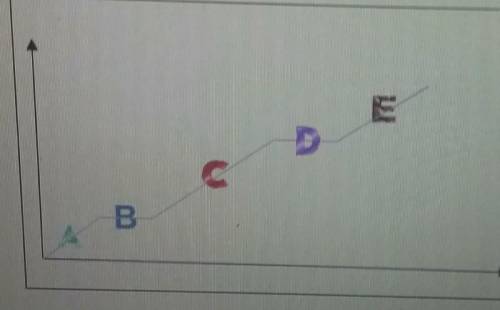
Physics, 15.05.2021 20:00 alexisfhenders
What value/s are increasing at points A, C, and E? what value/s are increasing at points B and D?


Answers: 1


Other questions on the subject: Physics

Physics, 21.06.2019 18:10, zuleromanos
An insurance company wants to know if the average speed at which men drive cars is higher than that of women drivers. the company took a random sample of 27 cars driven by men on a highway and found the mean speed to be 72 miles per hour with a standard deviation of 2.2 miles per hour. another sample of 18 cars driven by women on the same highway gave a mean speed of 68 miles per hour with a standard deviation of 2.5 miles per hour. assume that the speeds at which all men and all women drive cars on this highway are both approximately normally distributed with unknown and unequal population standard deviations.
Answers: 2

Physics, 21.06.2019 22:30, jasoncarter
The membrane surrounding a living cell consists of an inner and an outer wall that are separated by a small space. assume that the membrane acts like a parallel plate capacitor in which the effective charge density on the inner and outer walls has a magnitude of 7.0 × 10-6 c/m2. (a) what is the magnitude of the electric field within the cell membrane? (b) find the magnitude of the electric force that would be exerted on a potassium ion (k+; charge = +e) placed inside the membrane.
Answers: 1

Physics, 22.06.2019 00:10, oktacos
The energy released by a chemical reaction can be measured using a calorimeter. when barium hydroxide octahydrate crystals are reacted with dry ammonium chloride inside of a coffee cup calorimeter, the temperature of the 18.00 g of water in the calorimeter decreases from 30.0°c to 8.0°c. the equation for calculating energy absorbed or released by a reaction is: where q is the energy released or absorbed, m is the mass of water in the calorimeter, cp is the specific heat of water, and δt is the observed temperature change. if the specific heat of liquid water is 4.19 j/g·°c, how much energy was absorbed by the reaction?
Answers: 3

Physics, 22.06.2019 21:10, bri9263
Two masses are connected by a rope that hangs over a pulley as shown below. the pulley is a uniform cylinder of radius 푅=0.381meters and mass 푀=3.1푘푔. initially 푚"is on the ground and 푚#rests 2.5 meters above the ground. if the system is released, use conservation of energy to determine the speed of 푚#just before it strikes the ground. assume the pulley bearing is frictionless.
Answers: 2
You know the right answer?
What value/s are increasing at points A, C, and E? what value/s are increasing at points B and D?
<...
Questions in other subjects:

Mathematics, 02.03.2021 04:40


Mathematics, 02.03.2021 04:40


Mathematics, 02.03.2021 04:40





Mathematics, 02.03.2021 04:40




